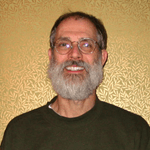James Winn

James Winn received three degrees from Illinois State University – a Bachelor of Science, Master of Science, and Master of Fine Arts (1982).
James Winn is an Illinois artist. He grew up in Illinois, studied in Illinois and has spent his career painting this Midwestern landscape. His work always feature a taut horizon line and the overarching sublime skies that breathe a sense of presence into the flat prairie below. Wnn has had numerous one-person exhibits in Chicago and New York; he also exhibits regularly in Santa Fe, Milwaukee, and many other cities. Winn is represented in private, corporate, and public collections from the Art Institute of Chicago and the State Department in Washington, D.C., to regional museums and university collections.
“Most of us have or at some point will return home to settle our parent’s estate, where we reintroduce ourselves to our tokens from our youth. I joined my siblings in this task recently. In the back of a closet I found an old portfolio containing my very early work, uncovering monochromatic watercolor still lives and charcoal drawings - exercises meant to teach students the craft-element of painting. There were also some later paintings, but they too revealed a young artist only interested in the process of painting. I threw most of them away. Before I attended ISU, I was trained at an art academy where I was taught how to make a painting, but at ISU I learned what it was to make Art.
It took a lot of art history and the patient mentoring of Professor Harold Gregor for me to make the transition from painter to artist. Understanding how past cultures used art to portray their ideas and values, and at times challenge the status quo, began to change my work. Observing my interest in landscape painting, Dr. Gregor insisted that I travel to Washington D.C. in 1980 to see a major exhibition of Luminists paintings. Standing in front of Frederic Church’s (1854-1900) “Twilight in the Wilderness,” 1881, I had an epiphany. All of those lectures on form and content, the challenges and exhortations in painting critiques, and the mountain of art books I had been tasked to read somehow came into a clear focus. That “somehow” was really nothing mystical; it was simply the intended results of a thorough education. Some brighter students may understand more quickly, but I am thankful that I was able to work with Dr. Gregor and others, like Ken Holder, long enough that the light went on for me. It was these experiences provided at ISU that transformed me from a painter to an artist.”